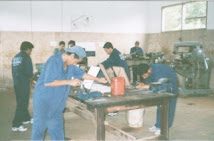
Nanoelectronics refer to the use of nanotechnology on electronic components, especially transistors. Although the term nanotechnology is generally defined as utilizing technology less than 100 nm in size, nanoelectronics often refer to transistor devices that are so small that inter-atomic interactions and quantum mechanical properties need to be studied extensively. As a result, present transistors do not fall under this category, even though these devices are manufactured with 45 nm or 32 nm technology.
Nanoelectronics are sometimes considered as disruptive technology because present candidates are significantly different from traditional transistors. Some of these candidates include: hybrid molecular/semiconductor electronics, one dimensional nanotubes/nanowires, or advanced molecular electronics.
Although all of these hold promise for the future, they are still under development and will most likely not be used for manufacturing any time soon.
Part of a series of articles on Nanoelectronics | |
| Single-molecule electronics | |
| Solid state nanoelectronics | |
| Related approaches | |
| See also | |
Contents |
Fundamental concepts
The volume of an object decreases as the third power of its linear dimensions, but the surface area only decreases as its second power. This somewhat subtle and unavoidable principle has huge ramifications. For example the power of a drill (or any other machine) is proportional to the volume, while the friction of the drill's bearings and gears is proportional to their surface area. For a normal-sized drill, the power of the device is enough to handily overcome any friction. However, scaling its length down by a factor of 1000, for example, decreases its power by 10003 (a factor of a billion) while reducing the friction by only 10002 (a factor of "only" a million). Proportionally it has 1000 times less power per unit friction than the original drill. If the original friction-to-power ratio was, say, 1%, that implies the smaller drill will have 10 times as much friction as power. The drill is useless.
For this reason, while super-miniature electronic integrated circuits are fully functional, the same technology cannot be used to make working mechanical devices beyond the scales where frictional forces start to exceed the available power. So even though you may see microphotographs of delicately etched silicon gears, such devices are currently little more than curiosities with limited real world applications, for example, in moving mirrors and shutters [1]. Surface tension increases in much the same way, thus magnifying the tendency for very small objects to stick together. This could possibly make any kind of "micro factory" impractical: even if robotic arms and hands could be scaled down, anything they pick up will tend to be impossible to put down. The above being said, molecular evolution has resulted in working cilia, flagella, muscle fibers and rotary motors in aqueous environments, all on the nanoscale. These machines exploit the increased frictional forces found at the micro or nanoscale. Unlike a paddle or a propeller which depends on normal frictional forces (the frictional forces perpendicular to the surface) to achieve propulsion, cilia develop motion from the exaggerated drag or laminar forces (frictional forces parallel to the surface) present at micro and nano dimensions. To build meaningful "machines" at the nanoscale, the relevant forces need to be considered. We are faced with the development and design of intrinsically pertinent machines rather than the simple reproductions of macroscopic ones.
All scaling issues therefore need to be assessed thoroughly when evaluating nanotechnology for practical applications.










Tidak ada komentar:
Posting Komentar